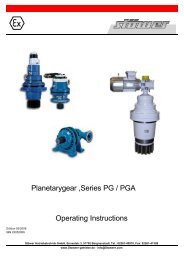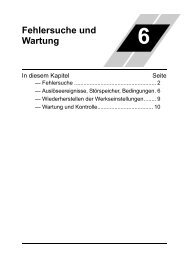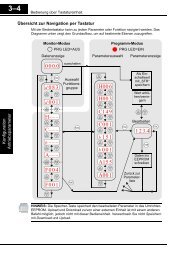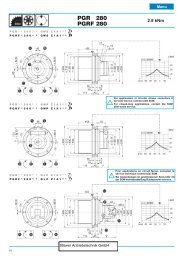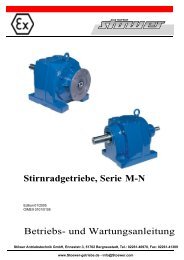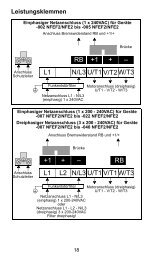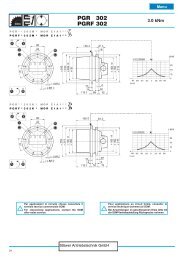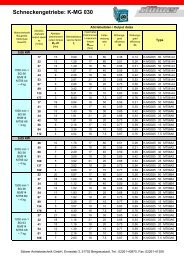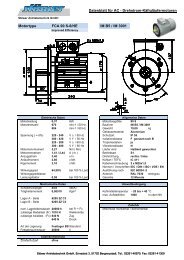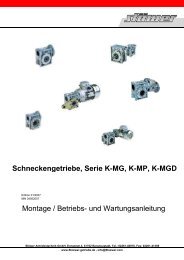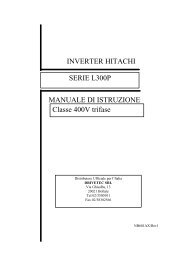pg _ pga series - Stoewer-Getriebe.de
pg _ pga series - Stoewer-Getriebe.de
pg _ pga series - Stoewer-Getriebe.de
You also want an ePaper? Increase the reach of your titles
YUMPU automatically turns print PDFs into web optimized ePapers that Google loves.
• I freni e gli attacchi motore<br />
assemblati formano una camera<br />
separata dal resto <strong>de</strong>l<br />
riduttore; bisogna pertanto<br />
provve<strong>de</strong>re al loro riempimento<br />
separatamente dal riduttore,<br />
ve<strong>de</strong>re capitolo<br />
FRENI (pag. 200).<br />
• I gruppi con servizio continuativo<br />
sono soggetti a surriscaldamento<br />
per la notevole<br />
quantità di olio in essi contenuta:<br />
in questi casi consigliamo<br />
l’uso di oli con una<br />
viscosità più bassa.<br />
I quantitativi di olio indicati nelle<br />
tabelle di catalogo, riportate per<br />
ogni gran<strong>de</strong>zza, sono puramente<br />
indicativi e sono soggetti a<br />
variazioni in funzione <strong>de</strong>lla configurazione<br />
<strong>de</strong>l riduttore: tipo di<br />
rapporto, freno, attacco motore<br />
e supporto in uscita.<br />
Durante il funzionamento la temperatura<br />
<strong>de</strong>lle superfici esterne<br />
non <strong>de</strong>ve superare gli 80°C.<br />
Se si verificano temperature superiori<br />
contattare il Servizio<br />
Tecnico-Commerciale SOM.<br />
• Brakes and assembled motor<br />
connections form a separate<br />
chamber from the planetary<br />
unit thus you need to fill them<br />
up separately, see Chapter<br />
BRAKES (page 200).<br />
• Units running on continuous<br />
duty are subject to overheating<br />
due to the high quantity<br />
of oil. If this is the case, we<br />
recommend using an oil with<br />
a lower viscosity.<br />
Please note that the oil quantities<br />
shown in the catalogue are<br />
approximate and are subject to<br />
changes caused by the planetary<br />
unit configuration: ratios,<br />
brake, motor connections and<br />
output adapters.<br />
During normal running, the temperature<br />
of the outer casing<br />
should not exceed 80°C.<br />
Should the temperature exceed<br />
80°C then contact the SOM.<br />
Technical-Commercial Service<br />
Department.<br />
• Les freins et les dispositifs <strong>de</strong><br />
couplage au moteur forment<br />
une chambre séparée du reste<br />
du réducteur; il faut donc<br />
les remplir séparément du réducteur,<br />
voir FREINS (page<br />
200).<br />
• Les groupes avec fonctionnement<br />
en service continu<br />
sont sujets à la surchauffe en<br />
raison <strong>de</strong> la très gran<strong>de</strong> quantité<br />
<strong>de</strong> lubrifiant qu’ils contiennent:<br />
dans ces cas, il est conseillé<br />
d’employer <strong>de</strong>s lubrifiants<br />
ayant une viscosité inférieure.<br />
Les quantités d’huile indiquées<br />
dans les tableaux du catalogue<br />
pour chaque dimensionnement<br />
sont purement indicatives et elles<br />
peuvent varier en fonction<br />
<strong>de</strong> la configuration du réducteur:<br />
type <strong>de</strong> rapport, frein, accouplement<br />
au moteur et support en<br />
sortie.<br />
Pendant le fonctionnement du<br />
réducteur, la température <strong>de</strong><br />
ses surfaces extérieures ne doit<br />
pas dépasser 80°C.<br />
Si vous constatez <strong>de</strong>s températures<br />
supérieures, vous<br />
adresser au Service Technico-Commercial<br />
SOM.<br />
CAMBIO OLIO OIL CHANGES<br />
VIDANGE ÖLWECHSEL<br />
• Effettuare il primo cambio olio<br />
dopo 100 ore di funzionamento.<br />
• I cambi successivi <strong>de</strong>vono<br />
avvenire dopo 2000 ore o almeno<br />
una volta all’anno.<br />
• Lo svuotamento <strong>de</strong>l riduttore<br />
va effettuato con l’olio ancora<br />
caldo, per evitare il <strong>de</strong>posito<br />
di morchie.<br />
• Pulire i tappi.<br />
• Prima <strong>de</strong>l riempimento con<br />
nuovo olio effettuare un lavaggio<br />
interno <strong>de</strong>l gruppo con<br />
liquido <strong>de</strong>tergente consigliato<br />
dal fornitore di lubrificante.<br />
• Controllare periodicamente<br />
che non vi siano perdite d’olio<br />
e che, a gruppo fermo, l’olio<br />
raggiunga il livello previsto.<br />
Se necessario, effettuare un<br />
rabbocco con lo stesso tipo di<br />
olio presente nel riduttore.<br />
• Attenzione:<br />
un rabbocco superiore al<br />
10% <strong>de</strong>l quantitativo totale<br />
può essere indice di perdita<br />
nel riduttore.<br />
24<br />
• The first oil change should be<br />
done after 100 working hours.<br />
• Subsequent oil changes should<br />
take place after 2000 hours<br />
or at least once a year.<br />
• In or<strong>de</strong>r to avoid sludge <strong>de</strong>posits,<br />
change the oil whilst<br />
the gear unit is still warm.<br />
• Clean all plugs.<br />
• For an effective oil change,<br />
the unit should be flushed<br />
through with a liquid <strong>de</strong>tergent<br />
recommen<strong>de</strong>d by the<br />
lubricant supplier.<br />
• Check periodically for oil leaks<br />
and the oil level while the<br />
unit is idling.<br />
If nee<strong>de</strong>d, top up the unit with<br />
the same type of oil.<br />
• Attention:<br />
if the quantity of oil used during<br />
topping up is greater<br />
than 10 percent of the oil capacity<br />
then check again for<br />
leaks.<br />
LUBRIFICAZIONE<br />
LUBRICATION<br />
LUBRIFICATION<br />
SCHMIERUNG<br />
• Faire la première vidange<br />
après 100 heures <strong>de</strong> fonctionnement.<br />
• Exécuter les vidanges suivantes<br />
toutes les 2000 heures<br />
ou bien au moins une fois<br />
pas an.<br />
• La vidange du réducteur doit<br />
se faire lorsque l’huile est encore<br />
chau<strong>de</strong> <strong>de</strong> façon à éviter<br />
les dépôts <strong>de</strong> cambouis.<br />
• Nettoyer les bouchons.<br />
• Laver l’intérieur du réducteur<br />
avec un détergent conseillé<br />
par le fournisseur du lubrifiant<br />
avant d’effectuer le remplissage.<br />
• Contrôler périodiquement<br />
qu’il n’y ait pas <strong>de</strong> pertes<br />
d’huile et que, lorsque le<br />
groupe est arrêté, l’huile atteigne<br />
bien le niveau prévu.<br />
Si nécessaire, rétablir ce niveau<br />
avec <strong>de</strong> l’huile du<br />
même type que celle se trouvant<br />
dans le réducteur.<br />
• Attention:<br />
une remise à niveau avec<br />
plus <strong>de</strong> 10% <strong>de</strong> la quantité<br />
totale <strong>de</strong> l’huile contenue dans<br />
le réducteur peut être un<br />
signe <strong>de</strong> fuite dans ce <strong>de</strong>rnier.<br />
STÖWER ANTRIEBSTECHNIK GMBH<br />
Menu<br />
• Die montierten Bremsen und<br />
Motoranschlüsse bil<strong>de</strong>n eine<br />
vom restlichen <strong>Getriebe</strong> - ausfuehrung<br />
getrennte Kammer;<br />
diese muß <strong>de</strong>shalb getrennt<br />
vom <strong>Getriebe</strong> aufgefüllt wer<strong>de</strong>n,<br />
siehe Abschnitt BREM-<br />
SEN (Seite 200).<br />
• Außer<strong>de</strong>m kommt es bei <strong>Getriebe</strong>n,<br />
die im Dauerbetrieb<br />
arbeiten, aufgrund <strong>de</strong>r darin<br />
enthaltenen großen Ölmengen<br />
leicht zu Überhitzung; in<br />
diesem Fall wird die Verwendung<br />
von Öltypen mit niedrigerem<br />
Viskositätsgrad empfohlen.<br />
Die in <strong>de</strong>n Tabellen <strong>de</strong>n einzelnen<br />
Größen zugeordneten<br />
Ölmengen sind Richtwerte, die<br />
je nach <strong>Getriebe</strong>ausführung<br />
und damit je nach Übersetzung,<br />
Bremse, Motoranschluß und<br />
Ausgangswelle variieren.<br />
Beim Betrieb sollte die Gehäusetemperatur<br />
von außen 80°C<br />
nicht überschreiten.<br />
Sollten höhere Temperaturen<br />
auftreten, wen<strong>de</strong>n Sie sich bitte<br />
an <strong>de</strong>n Kun<strong>de</strong>nservice (sales)<br />
von SOM.<br />
• Der erste Ölwechsel sollte<br />
nach 100 Betriebstun<strong>de</strong>n vorgenommen<br />
wer<strong>de</strong>n.<br />
• Weitere Ölwechsel sollten<br />
nach 2000 Betriebsstun<strong>de</strong>n<br />
bzw. min<strong>de</strong>stens einmal jährlich<br />
erfolgen.<br />
• Das Öl bitte bei noch warmen<br />
<strong>Getriebe</strong> ablassen. Auf diese<br />
Weise wer<strong>de</strong>n Ablagerungen<br />
vermie<strong>de</strong>n.<br />
• Ölstopfen reinigen.<br />
• Vor <strong>de</strong>m Auffüllen mit neuem<br />
Öl, das <strong>Getriebe</strong> innen mit einem<br />
vom Schmierstoffhersteller<br />
empfohlenen Reinigungsmittel<br />
auswaschen.<br />
• <strong>Getriebe</strong> regelmäßig auf<br />
Dichtigkeit prüfen sowie sicherstellen,<br />
daß bei Stillstand<br />
das Öl bis zum vorgesehenen<br />
Ölstand reicht. Sofern erfor<strong>de</strong>rlich,<br />
ist Öl nachzufüllen;<br />
<strong>de</strong>r Öltyp muß mit <strong>de</strong>m im<br />
<strong>Getriebe</strong> bereits enthaltenen<br />
Oel unbedingt übereinstimmen.<br />
• Achtung:<br />
Eine Nachfüllmenge, die 10%<br />
<strong>de</strong>r Gesamtmenge übersteigt,<br />
könnte auf eine Undichtigkeit<br />
<strong>de</strong>s <strong>Getriebe</strong>s hinweisen.



